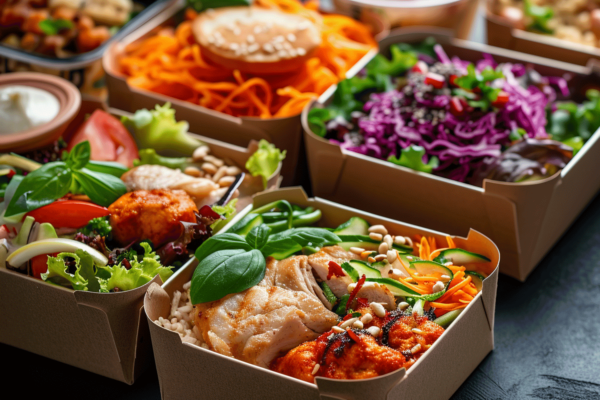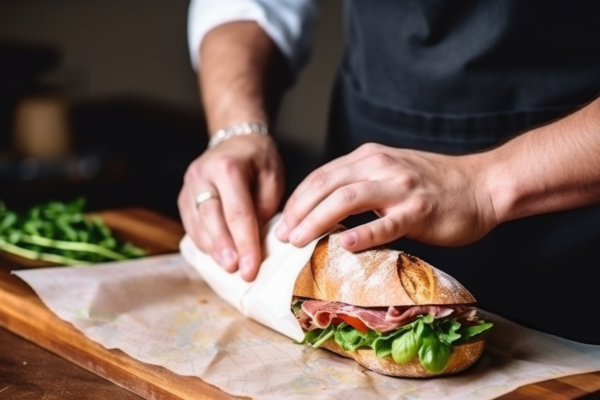Social media data for foodservice provides real-time consumer insights about food and beverage trends, flavor preferences, and dining behaviors. To use it effectively, you need to connect social listening with menu intelligence and consumer behavior data — not just scroll through feeds for hours. Integrated platforms deliver actionable insights without the overwhelm, helping restaurant operators, menu planners, and food and beverage manufacturers make faster, smarter decisions.
What Is Social Media Data for Foodservice?
Social data for innovation means using online conversations — from TikTok to Reddit — to identify early-stage food and flavor trends.
But social chatter alone doesn’t equal adoption. Datassential’s integrated system tracks both what people talk about and what operators launch, giving the industry’s clearest view of trend progression.
Social media data for foodservice refers to the insights extracted from online conversations happening across platforms like TikTok, Instagram and others. This data captures what consumers are saying about restaurants, food trends, beverage trends, flavors, ingredients, menu items, and dining experiences in real time.
For restaurant operators, catering companies, food manufacturers, and hospitality professionals, social media data reveals:
- Emerging food trends before they hit mainstream menus
- Consumer sentiment about specific ingredients, flavors, and cuisines
- Menu innovation opportunities based on what diners are excited about
- Competitive intelligence showing what’s working for other operators
- Regional taste preferences and how food trends vary by location
- Demographic differences in how Gen Z, Millennials, Gen X, and Boomers talk about food
The challenge isn’t accessing social media — it’s extracting meaningful business intelligence from millions of posts without getting lost in the noise.
Why Social Media Data Matters for Restaurant and Foodservice Success
Consumer Discovery Has Moved Online
Today’s diners — especially Gen Z and Millennials — discover new foods, restaurants, and flavors through social media before they encounter them in person. They’re learning about global cuisines like Korean, Filipino, and West African dishes through TikTok food creators, regional specialties through Instagram food tours, and ingredient innovations like alternative proteins and functional foods through influencer content.
If your menu development process doesn’t account for what consumers are discovering and discussing online, you’re operating with incomplete intelligence.
Food Trend Cycles Have Accelerated
The time between trend emergence and market saturation has compressed dramatically. Traditional pre-social media cycles took 3-5 years from emergence to mainstream. Current social media-driven cycles move from buzz to saturation in just 6-18 months.
Restaurant chains, independent operators, and food manufacturers who wait for traditional market research are often arriving after the opportunity has peaked. Social media data provides early warning signals — but only when you can interpret them correctly and act quickly.
The Problem: Social Media Overwhelm for Foodservice Professionals
Here’s what typically happens when restaurant operators and food industry professionals try to monitor social media:
You hear about a trending ingredient — say, gochugaru (Korean chili flakes) or chamoy (Mexican condiment). You open TikTok or Instagram to investigate. Two hours later, you’ve watched dozens of videos, seen hundreds of posts, and you’re no closer to knowing whether this trend is right for your menu or product line.
The Solution: Integrated Social Media Data for Foodservice
The answer isn’t to monitor social media more intensively or to ignore it completely. It’s to integrate social listening with the other business intelligence you need to make confident decisions.
What Integrated Social Media Data Looks Like
Instead of treating social media monitoring as a separate activity requiring different tools and workflows, integrated platforms bring social insights directly into your trend research and menu planning process.
Datassential One integrates social listening directly within the platform — positioned right alongside critical foodservice intelligence like:
- Consumer preference data showing which demographics favor specific flavors, ingredients, and formats
- Menu penetration rates revealing how widely adopted a trend is across restaurants
- Menu growth trajectories tracking whether adoption is accelerating or slowing
- Category context placing trends within broader menu category movements
- Trend lifecycle staging identifying whether trends are emerging, growing, mainstream, or declining
This integration means you’re not experiencing the chaos of unfiltered social media, and you’re not interpreting social signals in a vacuum.
The Power of Single-Platform Intelligence
When researching a potential menu item, ingredient, or product innovation, you can see the complete picture in one place:
Social conversation samples give you the qualitative flavor of consumer dialogue — what they’re excited about, how they’re using ingredients, which applications resonate — without requiring hours of scrolling.
Menu data shows you which restaurants have already added similar items, how penetration varies by segment (QSR, fast casual, casual dining, fine dining), and whether adoption is accelerating.
Consumer insights break down preferences by demographic (age, income, region) so you understand which customer segments are most receptive.
Competitive context reveals which operators in your segment or market are testing similar concepts and how consumers are responding.
Trend timing helps you understand whether you’re early, on-trend, or late to the opportunity.
This integrated approach transforms social media data from a time sink into a strategic asset. You get enough social intelligence to understand consumer sentiment and emerging patterns, without the overwhelm of unfiltered feeds.
Real-World Applications Across Foodservice Segments
Quick Service and Fast Casual Restaurants
QSR and fast casual chains need menu innovations that can scale, maintain speed of service, and appeal to mass markets. Social media data helps identify trends reaching critical mass across demographics, validate that discussions focus on formats compatible with operations, and time rollouts based on social momentum and menu adoption curves.
Example: Social buzz around spicy chicken sandwiches combined with menu data showing rapid adoption across multiple chains validated this as a category worth entering for operators who hadn’t yet participated.
Casual and Fine Dining Restaurants
Full-service restaurants need menu innovation that appeals to diverse age groups, provides shareable social media moments, and justifies dining out versus cooking at home. Social data identifies “Instagram-worthy” presentations, finds trends with cross-generational appeal, and helps balance familiar comfort foods with contemporary twists.
Example: Social conversations around loaded fries and elevated appetizers combined with menu data showing growth in shareable starters supported investment in premium, highly visual appetizer menus.
Food Manufacturers and CPG Companies
Product development cycles are longer than restaurant menu changes, so manufacturers need to identify trends with staying power, not just viral moments. Social media data distinguishes between fleeting fads and sustainable trends, shows both consumer interest and restaurant adoption, and identifies optimal timing for product launches.
Example: Social buzz around functional mushrooms (lion’s mane, reishi) combined with menu data showing beverages as the primary application guided product development priorities toward beverage applications.
Catering and Hotel Food & Beverage
Catering operations and hotel F&B need menu innovations that work at scale, travel well, appeal to diverse groups, and photograph well for event planners. Social data identifies trends with broad demographic appeal, formats that work for various service styles, and opportunities for themed menus.
Example: Social conversations around grazing boards and deconstructed presentations supported development of interactive food stations and customizable catering packages.
SEO and Social Media Data: How Search Behavior Complements Social Insights
Social media conversations and Google search behavior provide complementary intelligence:
What People Search vs. What People Post
Search behavior reveals active intent—looking for recipes, restaurants, menu information, and local discovery (“best tacos near me”). Social media behavior reveals passive discovery—seeing content from creators and friends, emotional response, and community participation.
Together, these data sources show both awareness (social) and intent (search).
High-Value Search Terms for Foodservice
Monitor search trends for:
- Ingredient searches: “gochujang recipes,” “ube desserts,” “chamoy sauce”—indicates consumer education and experimentation
- Format searches: “smash burger near me,” “poke bowl delivery,” “birria tacos”—shows active seeking behavior
- “Near me” searches: Strong signal of immediate purchase intent in specific markets
- Question searches: “What is [ingredient/dish]”—shows curiosity phase before adoption
Optimizing Your Restaurant or Food Brand for Search
Website optimization:
- Include trending ingredients and menu items in page titles, headers, and descriptions
- Create content that answers common food trend questions
- Optimize for local SEO with location-specific pages and Google Business Profile
- Use structured data markup for menus and local business information
Content strategy:
- Publish blog posts or videos addressing trending food topics relevant to your offerings
- Create recipe content featuring trending ingredients available on your menu
- Develop FAQ content answering common questions about global cuisines or preparation methods
- Share behind-the-scenes content about how you source or prepare trending items
Local SEO:
- Optimize Google Business Profile with accurate information, photos, and menu updates
- Encourage reviews mentioning specific trending menu items
- Use location-specific keywords in content
- Build local citations and ensure NAP (name, address, phone) consistency
Common Mistakes When Using Social Media Data for Foodservice
Mistake #1: Chasing Every Viral Trend
The problem: A video gets 10 million views and you immediately want to add the item to your menu.
The solution: Look for sustained conversation patterns, not isolated viral moments. Check whether menu adoption is following social buzz. Understand whether the trend fits your brand, operation, and customer base.
Mistake #2: Ignoring Regional and Demographic Context
The problem: Assuming a trend popular in Los Angeles or New York will work everywhere.
The solution: Analyze social conversation by geography and demographics. Understand that coastal urban markets often lead, but trends adapt as they spread. Test in markets where consumer preferences align with the trend profile.
Mistake #3: Prioritizing Volume Over Quality
The problem: Focusing on which trends have the most mentions without considering context.
The solution: Look at sentiment, engagement depth, creator adoption, and cross-platform presence. A trend with fewer total mentions but strong positive sentiment may be more valuable than high volume with superficial interaction.
Mistake #4: Treating Social Data as Predictive in Isolation
The problem: Assuming social buzz automatically translates to sales.
The solution: Social conversation shows awareness and interest, not purchase behavior. Always validate social signals with menu adoption data, consumer preference research, and test market results before significant investment.
Mistake #5: Analysis Paralysis
The problem: Collecting endless data without making decisions, waiting for perfect information that never comes.
The solution: Set decision timeframes and thresholds. Use integrated data to narrow focus and build confidence, then test and learn rather than researching indefinitely.
Mistake #6: Ignoring Operational Reality
The problem: Falling in love with trends that don’t fit your supply chain, skill set, or service model.
The solution: Filter trends through operational feasibility early in the research process. The most successful trends for your business are those you can execute consistently with quality and profitability.
The Future of Social Media Data in Foodservice
Advanced Pattern Recognition
Artificial intelligence and natural language processing are improving rapidly, enabling better culinary intent detection (distinguishing casual mentions from genuine interest), sentiment nuance understanding, predictive modeling that combines social trajectory with historical menu adoption patterns, and cross-platform synthesis connecting conversations across TikTok, Instagram, Reddit, YouTube and others.
Faster Decision Cycles
As integration improves, the time between signal detection and strategic response will continue to shrink through real-time trend monitoring, automated competitive intelligence, accelerated testing cycles, and dynamic menu optimization.
Better Risk Management
Improved data integration helps foodservice professionals avoid costly mistakes through fad detection (identifying trends with social buzz but weak menu adoption), oversaturation warnings, demographic mismatch identification, and operational incompatibility screening.
Competitive Advantages
The foodservice brands that thrive will be those who leverage integrated platforms combining social data with menu intelligence, act decisively on good information, test systematically using social signals to guide experiments, iterate quickly based on feedback, and maintain operational focus by filtering trends through capability and brand fit.
Key Takeaways: Social Media Data for Foodservice Success
- Social media reveals consumer awareness and interest — but menu data confirms whether trends are actually being adopted by restaurants
- Integration is essential — social signals need context from menu penetration, consumer preferences, competitive intelligence, and trend lifecycle data
- Time management matters — effective social data use means curated samples and integrated insights, not hours of unstructured scrolling
- Regional differences are significant — food trends spread unevenly across the U.S., and what works in one market may not translate to others
- Demographics determine adoption — Gen Z, Millennials, Gen X, and Boomers respond differently to food trends on social media
- Operational feasibility filters opportunity — the best trends for your business are those you can execute profitably and consistently
- Lifecycle timing affects strategy — entering trends at the right stage (emerging, growing, mature) determines potential success
- Test and learn beats analysis paralysis — use integrated data to make informed decisions, then validate through smart market tests
- Competitive advantages come from speed—brands that can act on integrated intelligence quickly capture opportunities others miss
- The future favors integration—standalone social listening tools lack the foodservice context necessary for confident decision-making
FAQ
What is social media data for restaurants and foodservice?
Social media data for foodservice refers to insights extracted from online conversations across platforms like TikTok, Instagram, Facebook, Reddit, and YouTube. It captures what consumers are saying about food trends, ingredients, flavors, menu items, restaurants, and dining experiences. For restaurant operators, menu planners, and food manufacturers, social media data reveals emerging trends, consumer sentiment, competitive intelligence, and regional preferences that inform menu development and product innovation.
How do restaurants use social media data?
Restaurants use social media data to identify emerging food trends before they hit mainstream menus, validate menu innovation ideas, understand consumer preferences by demographic and region, monitor competitors, plan limited time offers (LTOs), optimize menu positioning and pricing, and create marketing campaigns that resonate with target audiences. The most effective approach integrates social listening with menu penetration data and consumer research rather than relying on social signals alone.
What are the best social media platforms for food trends?
TikTok leads for trend discovery, especially among Gen Z consumers, with short-form video driving viral food trends. Instagram remains essential for visual food content, restaurant discovery, and food photography. YouTube provides recipe content and longer-form food media. Reddit offers authentic community discussions and local restaurant recommendations. Facebook remains relevant for local restaurant communities and demographic groups over 35. For comprehensive trend intelligence, monitoring across multiple platforms reveals more complete pictures than relying on a single source.
How much time should restaurant operators spend on social media monitoring?
With traditional manual monitoring, operators often spend hours scrolling without systematic results. The optimal approach uses integrated platforms that curate relevant social insights alongside other business intelligence, reducing active monitoring time to minutes of focused review rather than hours of unstructured scrolling. Datassential One integrates social listening directly within menu and trend research workflows, delivering actionable insights without the overwhelm of unfiltered social media feeds.
Can social media data predict menu success?
Social media data predicts consumer awareness and interest, but not sales performance in isolation. The most predictive approach combines social conversation volume and sentiment with menu penetration rates (how many restaurants have adopted the trend), menu growth trajectories (whether adoption is accelerating), consumer preference data by demographic, and regional variations. This integrated view helps distinguish between viral moments that fade quickly and sustainable trends worth menu investment.
What’s the difference between social listening and social media monitoring?
Social media monitoring tracks mentions, hashtags, and brand references—essentially counting what’s being said. Social listening goes deeper, analyzing sentiment, context, emerging themes, and consumer intent to derive actionable insights. For foodservice professionals, effective social listening also connects social signals to menu data and consumer behavior to understand not just what people are talking about, but whether those conversations are leading to restaurant adoption and purchase behavior.
How do food trends spread from social media to restaurant menus?
Food trends typically follow this pattern: (1) Early social conversation among food enthusiasts and creators, (2) Viral moment or sustained buzz on platforms like TikTok or Instagram, (3) Testing by independent restaurants and fast casual operators, (4) Menu adoption by early-mover chains, (5) Broader chain adoption as trend proves viable, (6) Mainstream acceptance across multiple segments. This cycle now happens in 6-18 months versus 3-5 years pre-social media. Brands that monitor both social signals and menu adoption can time entry strategically.
What are the biggest mistakes restaurants make with social media data?
Common mistakes include: chasing every viral trend without validation, ignoring regional and demographic context, focusing on mention volume over sentiment quality, treating social data as predictive without menu data validation, analysis paralysis from too much unstructured data, selecting trends that don’t fit operational capabilities, and entering trends too late in the lifecycle. The solution is integrated platforms that provide foodservice-specific context and filter social signals through menu reality and consumer behavior.
Do I need a special tool to track social media data for my restaurant?
While you can manually monitor social media, it’s time-intensive, unsystematic, and lacks foodservice context. Generic social listening tools track mentions and sentiment but don’t connect to menu data or consumer preferences. Foodservice-specific platforms like Datassential One integrate social listening with menu penetration data, consumer insights, trend lifecycle tracking, and competitive intelligence — giving you the complete picture needed for confident menu decisions without hours of scrolling. The investment pays off in time saved, better decisions, and reduced risk of costly menu mistakes.
How does social media data work with traditional menu planning?
Social media data complements rather than replaces traditional menu planning. It accelerates trend identification, provides early warning of emerging flavors and formats, validates concepts before expensive rollouts, reveals demographic and regional variations, and helps time menu changes to match consumer readiness. Traditional menu planning elements—cost analysis, operational feasibility, brand fit, and supplier relationships—remain essential. The most successful operators combine culinary expertise, operational excellence, and data-informed decision-making from integrated social and menu intelligence.
Looking to streamline your approach to social media data and food trends? Datassential One integrates social listening directly within the platform, alongside menu trends, consumer preferences, and competitive intelligence—giving you focused insights without the scroll.
 EN | English UK
EN | English UK DE | Deutsch
DE | Deutsch FR | Français
FR | Français IT | Italiano
IT | Italiano SP | Español
SP | Español





